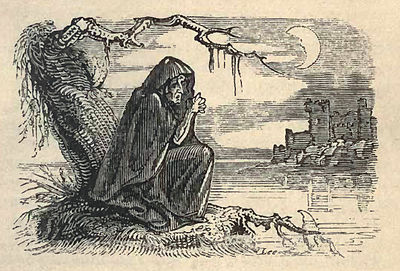
Along with Bono and the leprechaun, the wailing banshee is probably one of the best-known creatures to come out of Ireland. While some people consider it a spirit, others classify it as a kind of fairy. Its exact appearance also has a variety of interpretations, from depicting the banshee as being unusually tall or amazingly small, to rendering it as an ugly hag or a beautiful young woman. Despite the diversity of images, it’s generally agreed that hearing a banshee’s cry means that somebody in an Irish family is about to die.
Banshees are especially thought to shriek if the victim has a surname with the Gaelic prefixes Ó or Mac, or has a gift for singing and playing music. (The one indicates native Irish ancestry, and the other reflects the belief that music was a gift from fairies.) An account of a banshee, reported by antiquarian Thomas Crofton Croker in 1825, concerns a man who possessed the latter feature. In life, the 18th century reverend Charles Bunworth was a harpist as renown for his kindness as his talent for plucking. He earned his MA from Trinity College, Dublin in 1730, and served as the rector of Buttevant, a town in Ireland’s County Cork.
Bunworth was popular with both the rich and poor, but neither group seemed to love the rector as much as the country’s traveling harpists. In return for his support and patronage, Bunworth’s fellow musicians blessed him and praised his daughters in their songs. At the time of his death in 1770, Bunworth had fifteen harps in his collection, all of them presents from harpists who he’d helped over the years. Although one biographer in 1815 noted that Bunworth’s own harp was still being kept by his descendants, the rest of the collection was accidentally used as firewood by a caretaker in the family’s house.
More extraordinary than the fate of these unfortunate instruments might be the allegation that Bunworth’s death was preceded by a banshee’s cry. In his book Fairy Legends and Traditions of the South of Ireland, the earlier mentioned Croker states that “The circumstances attending the death of Mr. Bunworth may be doubted by some; but there are still living credible witnesses who declare their authenticity, and who can be produced to attest most, if not all of the following particulars.” According to Croker, the first sign that something was wrong happened a week before Bunworth passed away.
That evening, the members of the Bunworth household heard a noise that sounded like a sheep, but nobody paid it any mind. A few hours later, a herdsman named Kavanagh visited the Bunworths’ home with some medicine for the family patriarch, who’d fallen sick. When Kavanagh handed the bottle to one of Bunworth’s daughters, the lady noticed that the herdsman seemed upset. As he was questioned, Kavanagh mumbled something about his master and immediately broke into tears. Ms. Bunworth suspected that her overly emotional servant was drunk, but Kavanagh swore that his tears were sober ones.
Crying “We will lose him! We will lose him!,” Kavanagh revealed that he’d seen and heard a banshee on his way back home. Ms. Bunworth dismissed the monster as a superstition, but the herdsman was persistent. He claimed that as he passed through a glen, a long, white haired-banshee appeared and walked alongside him. The banshee clapped and screeched, chanting Bunworth’s name and keening (a poetical sort of lamenting done at traditional Irish funerals). Once Kavanagh reached an abbey, the banshee sat under a tree and “began keening so bitterly, that it went through one’s heart to hear it.”
It was not a keen, however, that went through Ms. Bunworth’s heart. She told Kavanagh that her father was improving, and asked that he not frighten the other servants with his silly banshee story. Nearly the whole week passed without further incident, but then something strange occurred the night before Bunworth died. That night, the old rector was sleeping in the parlor, under the watch of an elderly female friend. A group of men sat in the room next to them, and even more friends had gathered in the kitchen.
While watching Bunworth, the elderly friend suddenly heard a woman moaning and clapping her hands at a window near the rector’s bed. The aged lady alerted the men in the other room about the noise. They’d heard the commotion too, so a pair of skeptics volunteered to search the house. When they couldn’t find anything, the men went outside and investigated the road, still finding no trace of another human being.
After coming back into the house, the men were told that the moaning and clapping had intensified and stopped again during their absence. Right as the men closed the room’s door, the mysterious mourning broke out a third and final time. Bunworth’s health, already in bad shape, rapidly deteriorated. When the morning came, Charles Bunworth promptly went the way of all flesh, just as the banshee predicted.
If you enjoyed reading this article, please consider supporting my work by buying my book “Forgotten Lives” on Amazon here. My first collection of short stories includes the company of such wonderful people as a vengeful circus dwarf, a gourmet cannibal, and a mother who convinces her daughter that aliens are coming to abduct them. The book is available on Kindle, and it goes without saying that every purchase is preceded by a loud disembodied scream outside the buyer’s window.
